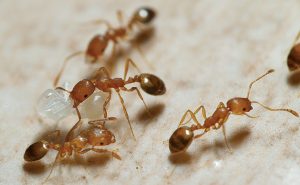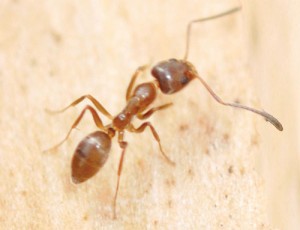Editor’s Note: Jai sent this blog post to us before the hurricanes hit. When we checked in on him and his team on Sept. 12, we were told they were planning to be back at work today. As his company’s web and marketing developer, Stephen Canipe, notes: “No matter where you go today, everyone looks a bit like a walking zombie. Nothing was open yesterday due to the storm, but today several of the roads have been cleared from the large trees that fell over them and people are out and about taking a look. There’s also lots of work to be done as far as cleaning up debris, unboarding windows, and things of that nature. It was a scary experience, but we Floridians are a tough bunch when it comes to hurricanes.”
 As the owner of a pest management company in the Tampa, Fla., market, I deal with so-called “sugar ants” every day.
As the owner of a pest management company in the Tampa, Fla., market, I deal with so-called “sugar ants” every day.
People call several species of ants “sugar ants” because they like sweets. Entomologists, however, identify the sugar ant formally as Camponotus consobrinus — which does not even live in Florida. It’s actually endemic to Australia. They are small as 2mm or can grow to 15mm. You can recognize the males by their black coloring. while the females have orange bodies. If you find them in the wild, they live in heaths, forest and woodlands. They prefer warm, humid climates.
But back to “sugar ants” in Florida. My pest management professional (PMP) colleagues agree that this catch-all term can mean such varied species as acrobat ants (Crematogaster spp.), ghost ants (Tapinoma melanocephalum), and odorous house ants (T. sessile). However, these are probably the Top 3 ant species that customers call sweetie:
1. Pharaoh ants (Monomorium pharaonis)

Photo courtesy of, and copyrighted by, Gene White, pmimages@earthlink.net
You will see pharaoh ants in food areas in factories, homes and hospitals. They are small (2mm), yellow to light brown and almost transparent. They are a major pest because they carry disease and contaminate sterile hospital areas and medical equipment.
Colonies have multiple queens and move their nests when disturbed. They form new colonies when a queen and a few workers leave the colony to start a new one. They also disperse in several locations when disturbed, sometimes spreading the infestation over a wider area.
Pharoah ants eat most anything but prefer sweets. They also eat other insects.
These ants survive quite well indoors. They can infest indoors and nest in many places, including:
- walls,
- cabinets,
- inside curtain rods,
- folds in sheets, papers, clothes,
- behind baseboards, and
- even in refrigerator insulation.
Like many other ant species, pharoah ants communicate through pheromones, which are chemicals they produce and use to send messages. There are different kinds of pheromones used to send specific messages.
Pharoah ants use pheromones to mark the trail to new food sources. Disturbing this trail is one way to disorient the ants — that is, until they remark the trail.
2. Argentine ants (Linepithema humile)

ARCHNEMESIS: Argentine ant
Photo: ©iStock.com/ paule858
Argentine ants also are commonly called sugar ants in Florida. These ants are light to dark brown in appearance and small (2.2 to 2.8mm). Argentine ant colonies are very large, sometimes with hundreds of queens, and have been known to infest entire city blocks. They nest in moist soil along buildings and sidewalks or under wooden boards, and they travel between their nests and their food source using trails.
Argentine ants eat almost anything, but particularly love sweets. They also eat honeydew made by aphids.
You will notice Argentine ant trails leading the ants up buildings and trees to get into a home. If they build nests in a residential account, it will be near moist, damaged wood, and inside walls. Argentine ants are difficult to get rid of and often come back year after year, even after treatment.
To help your program keep an Argentine ant population under control, recommend to the homeowners that they eliminate decaying plant matter and other things that hold moisture. Fix all water leaks, do not overwater lawns, and make sure gutter pipes lead roof water away from the building foundation. Trim all bushes around the building, and treat plants for aphid infestation to control their favorite source of food. (And of course, offer to do these services if they are unable or unwilling to do them — for an appropriate price!)
Inside the home, keep kitchens spotless and free of crumbs. Store all food (human and pets) in closed containers. Store food in the refrigerator where possible.
3. Tawny crazy ants (Nylanderia fulva, also called Rasberry crazy ants)

Tawny crazy ant workers with brood in Hancock County. PHOTO: Dr. Blake Layton
Crazy ants get their name from their unpredictable, frantic movements. They are indigenous to Southeast Asia, but found worldwide as they are an aggressively invasive species. They are dark brown to black and small (2.2 to 3mm). Their diet is omnivorous, eating insects dead or alive, honeydew, fruits, seeds, sweets and meats, grease, and other liquids.
Unlike other “Florida sugar ants” that prefer moist living, these ants can live in dry or moist areas. They survive in trash, rotten wood, soil, under rocks, under buildings. They do not like cold weather so they tend to try to come indoors into homes when it gets cold.
Crazy ant colonies are small compared to other sugar ants (usually fewer than 3,000 members), although they have multiple queens. They range quite far when foraging, which makes it difficult to follow their trails back to nests.
Preventive measures like caulking crevices in buildings and keeping food areas sanitary and free of loose tidbits helps eliminate ant food supplies and keep infestations down.
Leave A Comment